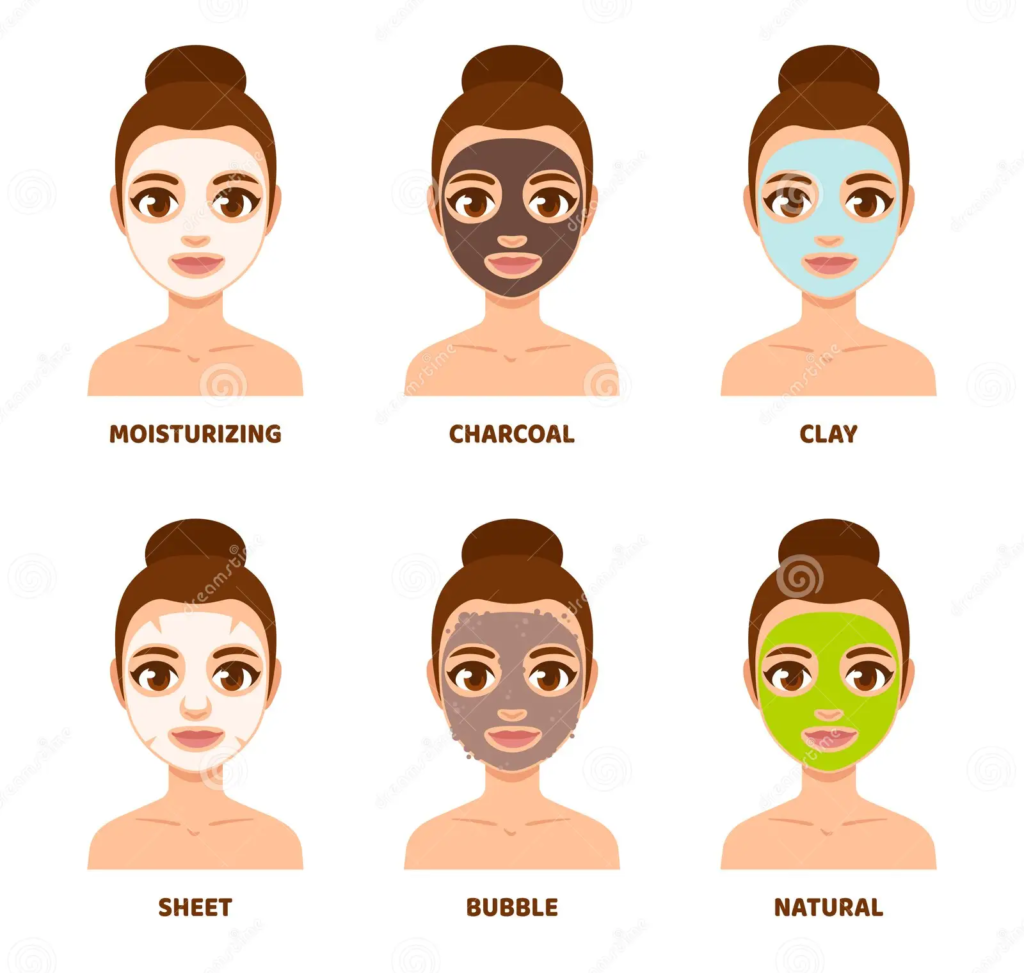A face mask is a skincare treatment designed to cleanse, hydrate, and rejuvenate the skin. Depending on the ingredients, face-masks can help with acne, dryness, oil control, and anti-aging.
Table of Contents
Different Types of Face Masks & Their Benefits

Choosing the right face mask depends on your skin type and skincare goals. Here are some common types:
1. Clay Mask
✅ Best for: Oily & Acne-Prone Skin
✅ Benefits: Absorbs excess oil, unclogs pores, and detoxifies skin.
2. Sheet Mask
✅ Best for: Dry & Sensitive Skin
✅ Benefits: Provides intense hydration and soothes irritated skin.
3. Peel-Off Mask
✅ Best for: Combination Skin
✅ Benefits: Removes blackheads, tightens pores, and brightens complexion.
4. Gel Mask
✅ Best for: Dehydrated & Sensitive Skin
✅ Benefits: Cools, hydrates, and reduces redness.
5. Exfoliating Mask
✅ Best for: Dull & Rough Skin
✅ Benefits: Removes dead skin cells, smooths texture, and boosts glow.
How to Choose the Best Face-Mask for Your Skin Type
- Oily Skin: Choose clay-based masks with charcoal or bentonite clay to absorb oil.
- Dry Skin: Use hydrating masks with hyaluronic acid or aloe vera.
- Sensitive Skin: Opt for soothing masks with chamomile or oat extract.
- Acne-Prone Skin: Go for detoxifying masks with salicylic acid or tea tree oil.
Top 10 Face Mask You Should Try in 2025
- Dead Sea Mud Masks – Best for detoxifying and acne-prone skin.
- Hyaluronic Sheet Masks – Ultimate hydration for dry skin.
- Charcoal Peel-Off Masks – Removes blackheads and deep cleanses.
- Turmeric Clay Masks – Brightens and reduces inflammation.
- Aloe Vera Gel Masks – Soothes sensitive and irritated skin.
- Vitamin C Sleeping Masks – Fights dullness and boosts radiance.
- Collagen Masks – Anti-aging and skin-plumping benefits.
- Matcha Green Tea Masks – Loaded with antioxidants for a youthful glow.
- Rose Clay Masks – Gently exfoliates and refines skin texture.
- Beetroot Powder Masks – Rich in vitamins for a natural glow.
Common Mistakes to Avoid When Using a Face Mask
- Leaving it on for too long – Can dry out the skin.
- Using the wrong type for your skin – Can cause irritation or breakouts.
- Skipping patch tests – Always test new products on a small area first.
- Overusing masks – Stick to 1-3 times per week depending on skin type.
How to Apply a Face Mask Correctly
- Cleanse your face – Remove makeup, dirt, and oil.
- Apply an even layer – Use clean fingers or a brush.
- Relax while it works – Follow the recommended time.
- Rinse thoroughly – Use lukewarm water to remove.
- Follow up with skincare – Apply toner, serum, and moisturizer.
DIY Mask for Natural Skincare
1. Honey & Turmeric Glow Masks
✔ Ingredients: 1 tbsp honey, ½ tsp turmeric
✔ Benefits: Brightens skin and fights acne
2. Oatmeal & Yogurt Hydration Mask
✔ Ingredients: 2 tbsp oatmeal, 1 tbsp yogurt
✔ Benefits: Moisturizes and soothes sensitive skin
3. Charcoal & Aloe Detox Mask
✔ Ingredients: 1 tsp activated charcoal, 1 tbsp aloe vera gel
✔ Benefits: Clears pores and controls oil
Check out our Instagram page – @Nivalisva
FAQs About Face-Masks
How often should I use a face-mask?
1-3 times per week, depending on skin type.
Can I use multiple face masks in one routine?
Yes! It’s called multi-masking – applying different face masks to different areas of the face.
What’s the best face mask for glowing skin?
Vitamin C, turmeric, and honey-based face masks work wonders for radiance.
Final Thoughts
Face-masks are an essential part of any skincare routine, helping to cleanse, hydrate, and rejuvenate your skin. Whether you’re looking for oil control, hydration, or anti-aging benefits, there’s a perfect face-mask for your needs.
If you’re ready to upgrade your skincare game, explore our best-selling face masks here!


5 Replies to